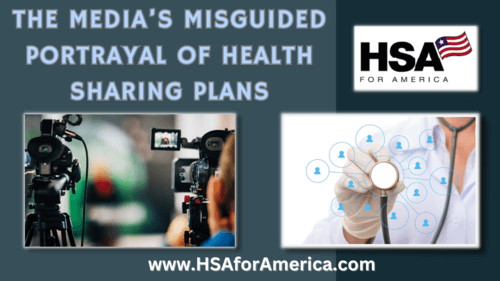
Today, nearly two million American families have dropped traditional health insurance coverage in favor of non-profit health sharing cooperatives, thanks to their lower costs compared to unsubsidized ACA Marketplace plans, their flexibility, and their risk reduction power.
But as is so often the case, most mainstream media outlets just don’t get it.
This article takes a close look at health sharing, as well as how they are misunderstood and misrepresented in many major media outlets.
What is Health Sharing?
Health sharing is a community-based, non-profit approach to helping individuals and families absorb the high cost of health care.
Health sharing organizations are voluntary associations of like-minded individuals who agree to help bear the medical expenses of fellow plan members.
Conceptually, health sharing organizations trace their roots back to the mutual aid societies of the 18th and 19th centuries.
Many, but not all health sharing organizations are faith-based. Some are non-denominational, and others are completely secular.
All of them, however, seek to help make healthcare more affordable for those in need by spreading the risk of high and catastrophic medical costs among thousands of members. So no member family needs to bear a major medical expense alone.
Health sharing plans aren’t a great match for everyone. For example, they typically impose waiting periods before they will share expenses related to most surgeries and pre-existing conditions.
But for those who don’t get a subsidy under the Affordable Care Act, and therefore have to pay the entire cost of a traditional Marketplace policy without government assistance, health sharing plans typically save up to half the cost of a traditional health insurance policy.
Hence their rapidly expanding popularity among those left out of the ACA’s subsidy schemes.
But because health sharing plans are different, they’re sometimes not explained well in the media.
This blog will address some of the most common myths and misconceptions surrounding health sharing and set the record straight.
Compare Pricing on the Best Insurance Plans Available
The Media Frequently Gets It Wrong
There is a vast cultural divide between Christians and other people of faith on one hand, and America’s newsrooms on the other.
Many mainstream media outlets don’t fully understand people of faith or the organizations that represent them.
This, in turn, leads to frequent mistakes in reporting.
For example, Newsweek once misquoted Jerry Falwell as describing his ministry as an “assault ministry.”
But any editor even casually familiar with Christian writing and apologetics would immediately have recognized Falwell as referring to a “salt ministry”.
Perhaps more perniciously, in a 1993 article, the Washington Post’s Michael Weisskopf famously described Christian evangelicals as “largely poor, uneducated, and easy to command”.
This unadulterated bigotry should have never made it past the copy editor’s desk. And the editors admitted such.
But this sentiment is so normalized in some communities that layers of editorial quality control somehow didn’t notice it.
It turns out there’s a lot more they don’t notice.
The Gelle-Mann Amnesia Phenomenon
The concept of Gelle-Mann amnesia, named after physicist Murray Gelle-Mann, sheds light on a critical aspect of media consumption.
It’s the phenomenon that occurs when individuals, despite recognizing inaccuracies in media reports on topics they are knowledgeable about, continue to trust the same media’s coverage on other subjects.
It’s an amnesia-like effect that contributes to people keeping the myths and misconceptions over the actual facts, as the public may overlook the media’s frequent inability to accurately report on complex or nuanced issues, such as the intricacies of health sharing plans.
This means people might keep believing the news about health sharing plans, even if they’ve seen mistakes in other stories, keeping the misconceptions caused from misinformation or a lack of understanding about how these plans operate.
Myth 1. Health Plans Should Provide Broad, Comprehensive Coverage or They’re No Good
The media often overlooks that many individuals don’t want expensive, comprehensive, “soup-to-nuts,” coverage.
Not everyone wants or needs a plan that provides first dollar coverage or a sub-$500 deductible.
Millions of people would prefer a lower-cost plan that focuses on catastrophic needs.
For example, many business owners and entrepreneurs may prioritize investing their free cash flow over paying for extensive insurance premiums.
But the Affordable Care act made these plans outright illegal to sell to most people, limiting them to those under 30 or meeting certain hardship criteria.
This perspective is frequently underrepresented in media discussions, which tend to assume a universal preference for traditional health insurance models over what an individual actually needs.
Many healthshare plans have options designed to focus on catastrophic needs, with members picking up more of the risk, in exchange for lower monthly costs.
Health sharing is simply meeting the demand—and doing so effectively, and at a fraction of the cost of a full-fledged unsubsidized Marketplace plan.
Myth 2: Health Sharing is a Type of Health Insurance
One common misconception is that health sharing plans are identical to traditional health insurance.
However, there are fundamental differences. Health sharing plans are not insurance products; they are cost-sharing arrangements among members who share similar values or beliefs.
While both systems aim to mitigate the financial impact of health expenses, the way they operate and manage risks is distinct. Health sharing plans typically involve a more community-oriented approach, whereas insurance is a contract with a company.
Myth 3: Lack of Regulatory Oversight Means Less Reliability
Health sharing plans are not regulated in the same way as traditional health insurance, leading to the myth that they are less reliable.
While it’s true that they don’t fall under the same regulatory framework, health sharing membership agreements are still contracts.
While they aren’t regulated specifically by state insurance commissioners, members still enjoy the protections of their states’ general contract law. If the health sharing organization breaches the contract, then the contract is still enforceable in court.
Furthermore, many health sharing plans have decades-long track records of reliability and member satisfaction.
These plans often have their own internal guidelines and systems to ensure fairness and financial responsibility. The key here is to do thorough research and choose a reputable health share organization.
Myth 4: People With Pre-Existing Conditions Can’t Join Health Sharing Plans
A common belief is that health sharing plans categorically exclude pre-existing conditions.
While it’s true that coverage for pre-existing conditions is more restricted than in traditional health insurance, they generally do become shareable after a waiting period.
This period varies among organizations. Some plans may also offer assistance or discounts on certain pre-existing condition treatments, even if not fully shared.
Myth 5: Health Sharing is Only For Christians
First, as we’ve already discussed, health sharing is not health insurance at all, and the two distinct concepts should not be conflated.
Second, health sharing is not exclusively Christian. In fact, anyone can join a health sharing plan.
Originally, many health sharing plans were faith-based and required members to adhere to specific religious beliefs.
Some health sharing plans still have a religious requirement. However, the landscape has changed. There are now health share organizations that serve the Jewish community, for example. Other nominally faith-based organizations are non-denominational. And still other health sharing organizations are completely secular – open to members of any faith or of no faith.
If you need help finding a health sharing plan that aligns with your religious views or values, we can help! Just make an appointment with a Personal Benefits Manager, and we’ll help you find a great health sharing plan that’s a good match for you.
Myth 6: Health Sharing Plans Restrict What Doctors You Can Use
Another myth is that health sharing plans restrict members to a limited network of healthcare providers.
In reality, many health sharing plans offer a great degree of flexibility in choosing healthcare providers. Unlike traditional insurance plans that have network restrictions, health sharing plans often allow members to visit almost any doctor or healthcare facility.
Myth 7: Health Sharing Plans Are Too Pricey
The notion that health sharing plans are more costly than traditional insurance is misleading.
Yes, those who qualify for significant subsidies under the Affordable Care Act may pay very low premiums out of pocket. But millions of Americans don’t receive a subsidy at all. And many others only receive a small one.
For these people, health sharing typically costs much, much less than the unsubsidized cost of a traditional qualified marketplace plan.
Myth 8: Health Sharing Coverage is Extremely Limited
The term “coverage” doesn’t really apply to health sharing plans. In the health sharing world, we say that medical expenses are “shareable” or “unshareable,” rather than “covered” or “not covered.”
This is to reduce the likelihood that consumers will confuse insurance and health sharing plans.
In any case, most health sharing plans will share a very wide range of medical expenses, comparable to those of traditional health insurance plans.
However, health sharing plans are less likely to share expenses for an abortion of a live fetus, drug or alcohol treatment, or treatment for medical incidents that arise directly from the abuse of alcohol and/or drugs used in violation of the membership agreement.
Additionally, health sharing plans don’t include a true prescription drug insurance component. Instead, they contract with pharmacies to create a discount plan that enables members to purchase drugs at up to 80% off the list price.
While each plan has its own guidelines and limitations, many offer comprehensive sharing options that cover a wide range of medical expenses, from routine care to major medical events. Some plans also offer additional wellness benefits and discounts.
Compare Pricing on the Best HealthShare Plans Available
SUMMARY: Health Sharing Is A Great Option for Millions of Americans
Health sharing plans offer a viable alternative to traditional health insurance for many people.
They provide an opportunity for members to be part of a community that shares healthcare costs in a way that aligns with their values and often at a lower cost.
While not suitable for everyone, these plans are an important part of the healthcare landscape and deserve to be understood and evaluated fairly.
By debunking myths and providing accurate information, we can ensure that individuals have all the necessary tools to make the best healthcare decisions for themselves and their families.
Remember, when considering a health sharing plan, it’s crucial to conduct thorough research, understand the specifics of the plan, and assess how it aligns with your personal healthcare needs and financial situation. As always, consulting with a Personal Benefits Manager is free, and there’s no obligation.
For Further Reading: The Health Care Affordability Crisis is Getting Worse. Here’s What You Can Do About It. | How to Combine a DPC Membership with a Health Sharing Plan | Turbocharge Your HSA: An Introduction to Self-Directed HSA Investing



